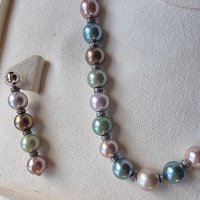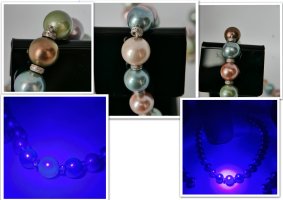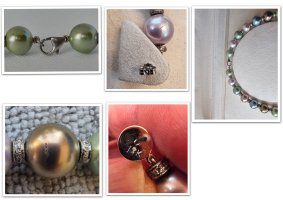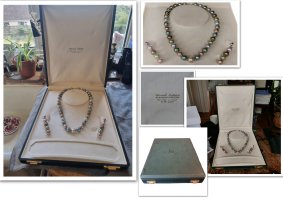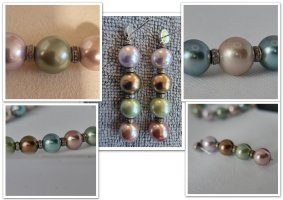Hello everyone,
I’m hoping to get some guidance on identifying a set of pearls I purchased with zero prior experience with pearls, and although I’ve researched online, I realise experience is key, and that’s where I need your help.
Here’s what I’ve observed so far:
I’ve read that pastel colors like green, red, and blue are generally not natural.
I measured the pearls using a digital Vernier calliper—none are exactly the same size, ranging from 11.97mm to 13.16mm.
The box bears the name of a prestigious jeweller in Abu Dhabi. However, I understand the pearls may not have originally come in this box.
None of the metal parts are magnetic (tested with a strong Earth magnet). The clasp is stamped 925, the earrings 18K, and the stones in the metal spacers are not diamonds but do sparkle in the light.
The pearl holes are approximately 1.0mm, and the string used is 0.80mm.
Some pearls feel gritty, while others do not, unless held firmly together.
Under UV light, they display a swirling fluorescent glow.
A couple of pearls have larger inclusions showing the shell’s thickness and underneath appears black.
The drilled holes vary—some are perfectly round, others show minor chipping.
I bought these pearls at an auction while waiting for something else, and I was drawn to their multi-coloured appearance. My bid was based on their aesthetic appeal and accept that my assumption that a box from a reputable jeweller would mean they were genuine was not the best logic.
Given the high cost of professional gemmological authentication, I hope someone with experience can interpret my photos and observations. I just want to know if they’re likely real or fake. The uncertainty is hard to explain , that the feedback will give me some clarification and direction would be great.
Thank you in advance for any guidance you can offer
I’m hoping to get some guidance on identifying a set of pearls I purchased with zero prior experience with pearls, and although I’ve researched online, I realise experience is key, and that’s where I need your help.
Here’s what I’ve observed so far:
I’ve read that pastel colors like green, red, and blue are generally not natural.
I measured the pearls using a digital Vernier calliper—none are exactly the same size, ranging from 11.97mm to 13.16mm.
The box bears the name of a prestigious jeweller in Abu Dhabi. However, I understand the pearls may not have originally come in this box.
None of the metal parts are magnetic (tested with a strong Earth magnet). The clasp is stamped 925, the earrings 18K, and the stones in the metal spacers are not diamonds but do sparkle in the light.
The pearl holes are approximately 1.0mm, and the string used is 0.80mm.
Some pearls feel gritty, while others do not, unless held firmly together.
Under UV light, they display a swirling fluorescent glow.
A couple of pearls have larger inclusions showing the shell’s thickness and underneath appears black.
The drilled holes vary—some are perfectly round, others show minor chipping.
I bought these pearls at an auction while waiting for something else, and I was drawn to their multi-coloured appearance. My bid was based on their aesthetic appeal and accept that my assumption that a box from a reputable jeweller would mean they were genuine was not the best logic.
Given the high cost of professional gemmological authentication, I hope someone with experience can interpret my photos and observations. I just want to know if they’re likely real or fake. The uncertainty is hard to explain , that the feedback will give me some clarification and direction would be great.
Thank you in advance for any guidance you can offer

